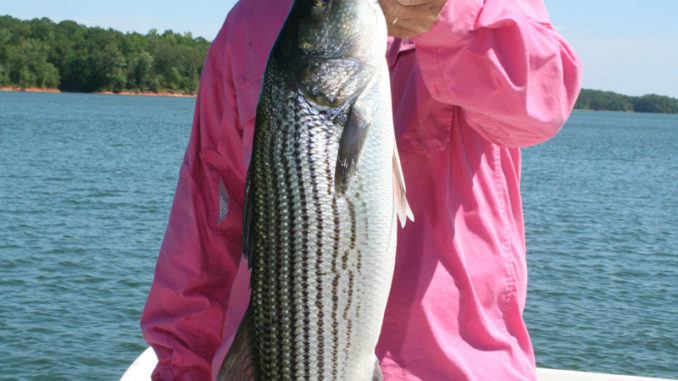
includes big stripers, spotted bass, perch and crappie
February is a month when you want both heavy tackle and light tackle in your boat when you go fishing on South Carolina’s Lake Russell, according to guide Wendell Wilson of Elberton, Ga.
It is a month for giant striped bass, plus white and yellow perch and spotted bass — and crappie come on strong, too, Wilson said.
The striper bite begins in January and stays strong through February when a few, scattered warming trends begin to take the winter chill off the water, said Wilson (706-283-3336).
“The warming trends don’t seem to affect the stripers very much; they move in March and April. They stay longer with the winter pattern than any other species,” Wilson said.
Striper activity is concentrated in the lower end of the lake, mostly in the main body and the mouths of creeks, and diving gulls are key to locating them when they’re feeding.
“When the birds are diving, the stripers usually will be up high in the water column, in the tops of the underwater trees,” he said. “You can catch them by throwing an Alabama rig or free-lining herring or medium shiners.”
Although these are bigger stripers, the bait needs to be small, he said, because they will be feeding on threadfin shad 1½ to 2 inches long.
“They are keying on the threadfins that are dying off and can’t get away in the lower water temperature that time of year,” Wilson said. “Whether you throw the Alabama rig or pull live herring or shiners, you need stout tackle, because they will be feeding near the trees, and we are talking big fish: 20- to 35-pound fish.”
In the same areas, he said, you can use lighter tackle to jig a spoon or drop-shot live medium minnows for white and yellow perch.
“Usually, they will be holding on the bottom in 40 to 50 feet of water. Thirty perch is a really good day, with some yellow perch up to 14 inches long,” Wilson said. “A typical day would be 50 fish overall, with 15 or so spotted bass, about 20 white perch and the rest yellow perch.”
As the water begins to warm, perch and spotted bass will move up from the deep flats to shallower areas, the sides of points, in 20 to 25 feet of water, he said.
“The crappie will also start staging in the mouths of the long coves and up a little farther in the creeks, maybe halfway up the major creeks. If you find a long cove going off the creek, they will be right in the mouth of that cove,” he said. “After a few long, warm, sunny afternoons, they will be up in about 15 to 20 feet of water.”
The best way to target the crappie, Wilson said, is to slow-troll 1/16-ounce jigs tipped with minnows.
“The color doesn’t seem to matter too much, but I usually like to tip hair jigs instead of curlytail jigs,” he said.

Be the first to comment